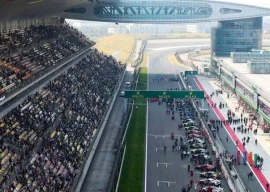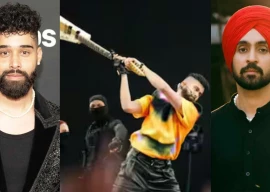
Popular art forms reflect subaltern expressions. Pakistan’s truck art is a case in point. The auto rickshaws have for decades displayed the imaginations and aspirations of ‘common’ folks. Rickshaw art also manifests our long art traditions, rooted in the daily life, a way for the underdogs to converse with urban elites. Rickshaw poetry has been recognised as a genre in its own. Take for example, ‘Maa ki dua, janat ki hawa’ (A mother’s prayer is a breeze from heavens) or Pappu yaar tang na kar, almost impossible to translate but equivalent of advising on taking a chill-pill. Drawings, posters and artwork on rickshaws, as political commentary (on inequality, heartless city life etc) have been flourishing for years.
On our highways, the truckers have been glorifying Gen Ayub Khan (1958-69), Pakistan’s first military dictator and a few politicians. Popular art has also challenged orthodoxy by drawing the legendary Buraq (an angel) and several Sufi saints and their miracles. Traditionally, the auto rickshaws were useful vehicles of party propaganda during election times with little loud speakers. However, the rickshaw owners would return to their original passions — love poetry that bemoaned a heartless beloved, wisecracks and of course, secular expressions of angst. During the last decade, Lahore’s rickshaws, not unlike the country, are undergoing a not-so-subtle metamorphosis.
First came the aggressive marketing of religious congregations. Advertising for private tuition centres and faith healers followed. In the recent months, this space has been appropriated by the messages of the Pakistan Defence Council. This coalition of rightwing extremism, articulating an anti-India and hate-America agenda has been rather inventive. Countless rickshaws in Lahore and its surrounding areas advertise the burnt bodies of Gujarat and Samjhauta express victims. The common slogan loosely related is: “There can be only one kind of relationship with India (Bharat); based on hatred and seeking revenge” via jihad. India’s alleged theft of our waters is also highlighted ad nauseam.
During 2011, these messages have been flashing across Lahore. This sort of campaign is obviously ‘sponsored’ and those behind it are too powerful for any authority to take note of. The political party, which rules Lahore, entered into a historic agreement with India’s Prime Minister Atal Behari Vajpayee in 1999 and is committed to peace with India. The federal coalition comprising the PPP, the ANP and the MQM are all in favour of establishing peaceful relations with India and advancing the trade agenda. In fact, the ANP and the MQM have been accused of being soft on India and their party leaders’ statements have been called into question by the hyper-nationalists.
If almost all of people’s representatives in parliament do not agree with the shenanigans of the PDC which some call a proxy of Pakistan’s de facto rulers — the various arms of the ‘Deep State’ then why are they not countering this onslaught of propaganda that gets into popular domain via live transmission of PDC rallies, through popular art and even social media? How much can civil society — that is afraid of extremists — do when those enjoying power at the centre and provinces are not willing to stick their necks out?
Why is the Lahore city administration not taking note of these vile messages? Some of the images are visually disturbing for children who are frequent users. Is there no other way to articulate our concern for water scarcity and ‘war’ with India? Extremism is slowly destroying the culture Lahore was once proud of.
Newer and popular expressions of jihadi ideology are impositions from the above and do not reflect the imaginations of the artists and drivers. Our public spaces are turning into haunting grounds of militaristic might and jihadi discourse. Challenging it is the first step towards changing our country.
Published in The Express Tribune, February 26th, 2012.
COMMENTS (33)
Comments are moderated and generally will be posted if they are on-topic and not abusive.
For more information, please see our Comments FAQ


















1713264570-0/Tribune-Collage-Feature-Images-(9)1713264570-0-270x192.webp)


























@Habeeb Akhtar: "After reading this thought provoking story by Rumi, and seeing the large number of comments by both Muslims and Hindus, illuminating and ill-informed, all I can add is that Hindus responsible for the carnage must be booked if India wishes to remain a secular, well-knit democracy"
The people responsible for Samjhauta express are already in jail. When it comes to Gujarat - you must understand they were riots. There was an initial act of terror - 57 Hindu pilgrims were burnt alive by Muslims in Godhra. This led to 2 days of rioting in which 750 Muslims and 370 Hindus died. After that the army was called and calm was restored. More people die in target killing every year in Karachi. In Gujarat n fact there have been no Hindu Muslim riots in the last 10 years. So India's secular culture is safe - thank you very much. Pakistan needs to worry about its own radicalizatipn.
I think the whole context of the article has been lost in the pithy battering that is taking place in the comments box. The point is not what you believe (or don't believe), but rather do we need public platforms like the rickshaw to invite more hatred and violence when there isn't enough money or resources going around to feed the poor man. Also, the article laments the loss of the romantic soul that our people once possessed - that seems to be overlooked by the readers.
Whether real, fabricated, created or otherwise, the danger of radicalizing everything and everyone is evident everywhere we go today. Our energies are focused more on self destruction rather than rebuilding and reconstructing of our foundations.
Forget propagandizing for once - a peaceful equilibrium in society is the right of every liberal, conservative, religious or atheist citizen of this country.
After reading this thought provoking story by Rumi, and seeing the large number of comments by both Muslims and Hindus, illuminating and ill-informed, all I can add is that Hindus responsible for the carnage must be booked if India wishes to remain a secular, well-knit democracy. Having said this I also ask how come the Muslims - of the sub-continent, as well as of the rest of the world - have landed themselves in such a despicable situation where dispensing with them has become an every day occurrence. A recent Urdu book I read by an Indian, Hasan Jowher, lists various reasons, with which I can hardly disagree. I think every Pakistani should read it.
Together men and women of goodwill of both the countries must hang their heads in shame for what they made of their countries and then put their heads together to find how they can lead the world in the ways of peaceful co-existence.
@Ramanujam: And the worst thing about the Godhra riots is that Hindu deaths are never mentioned in the context of victims or massacres or pogroms.
Poor rickshaws can be excused ,they have not been fortunate enough to go to school. But what about the so called educated elites, in whose (majority) sitting rooms all I hear is unbridled hatred against US,India,Israel,Europe,Christians,Hindus,Jews,Shias,Ahmadis,Atheists and so on. Those rickshaws are symptoms,the disease is elsewhere..
This only means things will get worse before they get better. Propoganda in Pakistan, that only poisons Pak society, has not hit the bottom yet.
Pakistan is going down the drain with its Indian obscession. Go ahead, display your anti-indian rehtoric, its only going to harm you in the long run. The resuts have already started showing.
Muslims are a separate nation not just relative to Indian but other nations as well.
In the 1960s vehicles in Pakistan started displaying stickers saying 'Crush India'. The rest is history.
Wise people have said, 'History Repeats Itself'.
pics?
The leaders of PDC using public spaces to polarize the opinion of the people of Pakistan against India is sad and needs to be condemned. These idiots must be reminded that it was people like them, who have a perverted understanding of nationalism and patriotism, that were responsible for the massacre of Muslims in Gujarat. Whatever happened in Gujarat in 2002 needs to be condemned and there is a legal process currently underway in India to fix the accountability and punish the guilty. It doesn't mean that the abuses committed in Gujarat be used to spread hatred among communities. There is a bright side to India too that should be explored to bridge the two nations. Hatred only evokes more hatred which is not good for both India and Pakistan.
very well pointed out. i don't know where our society is heading towards!!! its time that we should realize that we have people within our own rows who are more dangerous than India .we need to mend our ways.
As always, Mr. Rumi raises a valid point on the development of Pakistan's society in relation to governance. The two issues cannot be seperated and his words are especially powerful, "Our public spaces are turning into haunting grounds of militaristic might and jihadi discourse. Challenging it is the first step towards changing our country." Great column
"Challenging it is the first step towards changing our country."
Very well said, Sir.
But, who will challenge, and how?
I wonder if it is not too late already.
@Raja Rumi You should continue your efforts to normalize the relation between 2 countries . Some people like both Hamids and Maqbul Jan who is proud of his Arabic ancestry have their blood still hot after so many years of rivalry.Nobody gains from this rivalry ,but fire of anger and revenge kills the one who keeps it within him . Many generations have been wiped out . While persons like Raja Rumi,Hassan Nisar,Hoodbhoy,Najab show some hope to us , .........
If pakis are so concerned about muslims of India, then they must arrange to rehabilitate indian muslim s in pakistan itself, as after creation of pakistan all muslims living in India are not citizen of india, they are citizen of pakistan.
And the most effective way to challenge the jihadi rickshaw campaign is....?
@shouvik mukherjee: You are right but that does'nt justify the gujrat killings and samjhota express carnage especially samjhota victimes .they were muhajirs of new karachi and hyderabad going to meet their near and dear ones separated due to partition.Think for a moment how painful it is to be uprooted from ones hearth and homes.that has been the lot of the muhajirs.personally i belong to the generation which has memories of his left behind home and relatives.
A good article Rumi, We should also ask these deep state cronies, and Khao Mullha why they are silent on killing of innocent people by those who shared their ideological theme.. Honestly what I want from rulers, please kills theses empty heads, they are not only destroying our society domestically but on International level spoiling Pakistan identity. Please get rid of them and stop the flow of Saudi and Kuwaitee money in Pakistan so our society can be save from these mad people.
Gujrat on Pakistan's Rickshaws too. Really,MODI is GREAT
There is a parallel news item in which PM Gilani says that Pakistan is a powerful strong country and is going forward on all fronts. What an ironical denial - hallmark of everything in Pakistan.
Numer of Muslims killed by Muslims in Pakistan are far more than number of Muslims killed in Gujrat and Samjhauta express.
I suppose Rickshaw’s in Lahore will never show picture of massacre of Palestinian by General Zia ul Haq.
September 1970 is known as the Black September (Arabic: أيلول الأسود aylūl al-aswad) in Arab history and sometimes is referred to as the "era of regrettable events." It was a month when Hashemite King Hussein of Jordan moved to quash the militancy of Palestinian organizations and restore his monarchy's rule over the country On September 15, King Hussein declared martial law. The next day, Jordanian tanks (the 60th Armored Brigade of the Jordanian Army) attacked the headquarters of Palestinian organizations in Amman; the army also attacked camps in Irbid, Salt, Sweileh, Baq'aa, Wehdat and Zarqa.
Then the head of Pakistani training mission to Jordan, Brigadier Muhammad Zia-ul-Haq (later Chief of Army Staff and President of Pakistan), took command of the 2nd division. Arafat later claimed that the 2nd division of Jordanian army killed between 10,000 and 25,000 Palestinians,
excellent op-ed. I feel sorry to realize that such articles are only limited to English press. When will our Urdu press wake up to these cruel realities? Lahorites, will have to play a vital role to stand against terrorism, extremism, exploitation and repression of smaller provinces, especially Balochistan.
So now you want to restrict the freedom of expression of rickshaw walas under the pretense of "civil society."
I just bought a sticker of burnt bodies for my car as well. I will display it on my car's rear window and flash it right in front of your eyes, Mr Rumi. If you do not like it, close your eyes.
Jihadi groups have essentially become a business. Money comes from local charity or petro dollars. Children from poor families become cannon fodder. State achieves its stupid defence policy aims. And organizers and top mullahs earn wealth, power and fame. For the elites, it’s a win-win situation. It’s a tragic irony that the real losers are those foot soldiers who get killed in foreign lands, and I am afraid, they won’t even get their 72 virgins.
Sorry but Pakistan's most prosperous and supposedly educated province is going to dogs, time for the people to wake up.